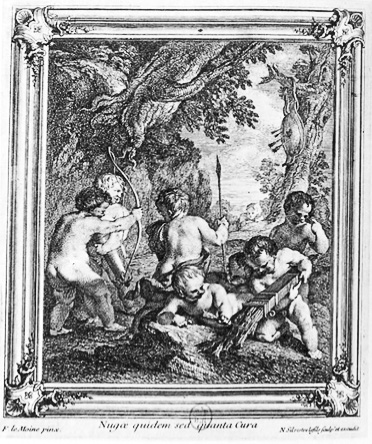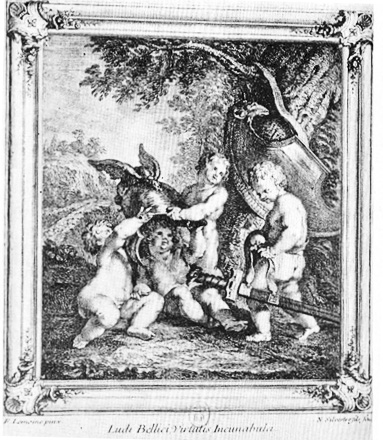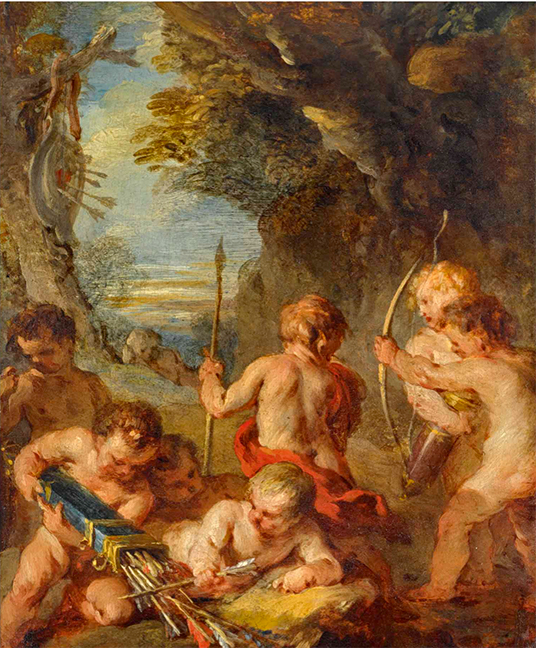
- Home Page
- Accepted
Paintings & Copies - Doubtful
Attributions - Doubtful Textual References
- Alternative
Titles - Collectors &
Museums - Bibliography
- Search Abecedario
- Watteau &
His Circle
X. Enfans jouant avec des fleches
Entered November 2014; revised February 2021
New York, Collection of Colin Bailey and Alan Wintermute
Oil on panel
13.6 x 18.6 cm
ALTERNATIVE TITLES
Enfants tirant à la cible
Putti Drawing the Bow
Putti Playing in a Landscape
Putti Playing with the Accoutrements of Diana
Putti Playing with the Arms of Diana
Six enfans jouant avec les attributes de l’Amour
PROVENANCE
Paris, collection of Jean François de Troy (1679-1752, artist); his sale, Paris, April 9-May 5, 1764, lot 133: “François le Moine . . . Deux Tableaux des plus précieux de ce grand Peintre, ils représentent des enfans, les uns qui jouent avec les armes de Dieu Mars, & les autres avec des fleches; ils sont sur bois & portent chacun 4 pouces 9 lignes de haut, sur 4 pouces de large.” The pair sold for 230 livres to Menageot according to the Getty Provenance Index.
Paris, collection of François Michel Harenc de Presles (1710-1802, banker). His sale, April 16-24, 1792, lot 55: “F. LE MOINE . . . Deux Tableaux. L’un composé de quatre enfans qui jouent avec les armes de Mars. L’autre offer six enfans jouant avec les attributs de l’Amour, ces duex jolis Tableaux sont d’une couleur vigoureuse & pleins de goût. On sait qu’il est difficile de trouver d’aussi petits morceaux du célébre peintre du sallon d’Hercule à Versailles. Hauteur 5 pouces, largeur 4 p.” The painting was withdrawn from the sale according to the Getty Provenance Index. There is a slight but excusable error in the description: the painting depicts eight putti but two are seen only partially.
Paris, collection of François Michel Harenc de Presles (1710-1802, banker). His sale, April 30ff, 1795, lot 64: “F. Le Moine . . . Deux Tableaux. L’un composé de quatre enfans qui jouent avec les armes de Mars. L’autre offer six enfans jouant avec les attributes de l’Amour, ces deux jolis tableaux sont d’une couleur vigoureuse et pleins de goût. On sait qu’il est difficile de trouver d’aussi petits morceaux du célèbre Peintre du sallon d’Hercule à Versailles. Hauteur 5 pouces, larger 4 pouces.” The painting sold for 701 assignats to the dealer Joseph Alexandre Lebrun, according to an annotated copy of the catalogue at the Rijksbureau voor Kunsthistorische Documentatie.
Burnham (Bucks), collection of Wakefield Christie-Miller (né Christy, d. 1903). The painting is reputedly listed in the Britwell Court Catalogue of 1894.
Salisbury, Clarendon Park, collection of Major Samuel V. Christie-Miller (1912-1968), c. 1950-60.
Collection of “a Lady.” Her and others’ sale, London, Sotheby Parke Bernet, July 7, 1976, lot 50: “A. WATTEAU . . . PUTTI PLAYING IN A LANDSCAPE / In the foreground a putto holding a quiver, two others beside him; more putti flexing a bow beneath trees to the right. On panel 5 3/8 x 4 ¼ in. / 13.5 x 11 cm. The Royal Academy catalogue of 1954-55 suggests that this is an early work and that the motive is derived from a background scene in one of Albani’s roundels in the Borghese Gallery. Collections: W. Christie-Miller (Britwell Court Catalogue, 1894); Major S.V. Christie-Miller Exhibited: London, Royal Academy, European Masters of the Eighteenth Century, 1954-5, No. 243 (as by Antoine Watteau).” According to the auction house’s coded system, the use of just the initial for the artist’s first name rather than its full form indicates that it did not believe it was a work by the artist but that it was “a work of the period of the artist which may be wholly or in part his work.” The painting sold to Faustus Gallery for £1,100 with premium.
New York, with Bob P. Habolt & Co.; sold to Ambassador and Mrs. Felix Rohatyn.
New York, collection of Ambassador Felix George Rohatyn (1928-2019; banker and diplomat) and Elizabeth (née Fly) Rohatyn (1930-2016). Their sale, New York, Sotheby’s, October 14, 2020, lot 27: “FRANÇOIS LEMOYNE / PUTTI PLAYING IN A LANDSCAPE . . . oil on panel / painted surface: 5 3/8 by 4 ¼ in.: 13.5 by 10.6 cm. / with additions: 5 ¾ by 4 ½ in.; 14.6 by 11.5 cm. / Condition Report . . . Provenance / . . . Literature / Exhibited / Catalogue Note / This small sketch by François Lemoyne along with its pendant in the Harvard Art Museums (inv. no. 1930.184), once belonged to the artist Jean François de Troy. Both were engraved as a pair by Nicolas Charles de Silvestre, but by the early 19th century, the two were separated from one another and their attributions. Having once been called Fragonard and Watteau, the present example was returned to Lemoyne’s corpus in 1958 by Levy, though Lemoyne seems to have drawn direct inspiration from Watteau’s Cupid’s Realm of circa 1709.1 [Oil on canvas. 13 by 17.8 cm. private collection. See Baillio 2005, cat. no. 41.]" Bought after the sale by Colin Bailey and Alan Wintermute.
EXHIBITIONS
London, Royal Academy, European Masters of the Eighteenth Century (1954), cat. 243 (as by Watteau, Putti Playing in a Landscape, lent by Major S.V. Christie-Miller).
SELECT BIBLIOGRAPHY
Mathey, “Early Paintings of Watteau” (1956), 21-22.
Lévy, “Watteau et Le Moyne” (1958), 347-52.
Watson, “Watteau, Peintre Inconnu” (1962), 126.
Macchia and Montagni, L’opera completa di Watteau (1968), cat. 1o-A.
Bordeaux, Le Moyne (1984), cat. 39.
REMARKS

Nicolas Charles de Silvestre after Françcois Lemoyne, Enfans jouant avec les armes de Diane, engraving.

Nicolas Charles de Silvestre after Françcois Lemoyne, Enfans jouant avec les armes de Mars, engraving.
That this painting is actually by François Le Moyne (1699-1767) is beyond doubt. It was one of a pair of paintings engraved by Nicolas Charles de Silvestre (1699-1767). This scene of putti playing with bows, arrows, and a spear was titled Putti Playing with the Arms of Diana and the caption below proclaims “Le Moyne pinxit.” The pendant painting, now in the Fogg Museum, Cambridge, shows four putti playing with the arms of Mars, namely a large helmet and a sword. The pendants had been together in the collection of the painter Jean Francois de Troy, and then were sold in 1764 under Le Moyne’s name. They remained together and with Le Moyne’s name attached in subsequent sales in 1792 and 1795. Then, in the last years of the eighteenth century or, more likely, in the first half of the nineteenth century, the pendants were separated and the authorship of this work was forgotten.
In the late nineteenth century, while in Christie-Miller’s collection at Britwell Court, it was classified as an anonymous work. It did not come into the public spotlight until after World War II. Jean-Luc Bordeaux claims that at some point the painting was given to Fragonard and then was attributed to Watteau by Sir Karl T. Parker. By 1954, when the work was shown in the Royal Academy’s winter exhibition in London, the attribution to Watteau was in place. In his inclusionist approach to art, Mathey quickly seized upon it and made it an integral part of a group of paintings with putti and children that he proposed giving to Watteau, almost none of which are actually by the artist. The association of this painting with Watteau was stopped abruptly by Jean Lévy’s discovery that it was documented as having been attributed to Le Moyne in the mid-eighteenth century. Its size and panel support, as well as the Silvestre engraving constituted incontrovertible proof. Subsequently Mathey withdrew his claim of an attribution to Watteau. In his 1959 publication of Antoine Watteau, Peintures réapparues, he left all the other pictures with putti and children together as a supposedly integral group and silently passed over the removal of this one.
Enfans jouant avec des fleches and its pendant belong to a French tradition of light-hearted scenes of children associated with classical attributes. The classical elements were, however, a superficial element and nowhere is this better demonstrated than in the various titles given to this painting. While the large helmet and sword in the pendant were consistently associated with Mars, the god of war, the bows and arrows in our painting were more open to interpretation. The Silvestre engraving intoned Diana, the goddess of the hunt, and in the 1764 sale, they were not linked with any god. But in the 1792 and 1795 sales they were seen as the attributes of Cupid, which is more likely since Cupid is directly linked with Venus, and she is frequently coupled with Mars. Moreover, paintings with Venus accompanied by putti shooting bows and arrows—from Albani to Watteau—were then a fashionable subject. Tellingly, throughout most of the late twentieth century, the painting was presented as just a scene of playful cupids without any association with pagan gods.
